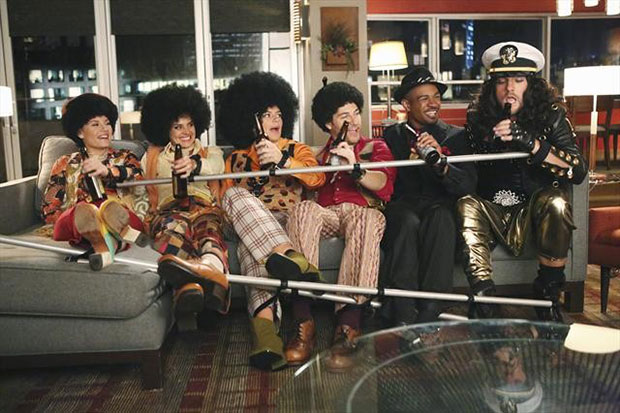Each year the major networks trot out a slew of sitcoms that pretty much look the same as each other and most of the sitcoms that came out the year before. And the year before that. And the year…you get the idea. But there are a few sitcoms that truly rise above the tropes of the form and do something just a little bit different.
Seinfeld.
30 Rock.
Parks and Recreation.
It’s Always Sunny in Philadelphia.
Arrested Development.
Each one of these shows elevated the sitcom format beyond what anyone thought it was truly capable of. And each has received recognition in their own way, some in the form of awards and others in a cult following. But there are other shows that fly completely under the radar, never quite breaking through in their short runs and remain a hidden gem.
Happy Endings is one of those shows.
When it first appeared on ABC in 2011, Happy Endings was greeted as another ensemble cast Friends clone. And for the first few episodes, that’s exactly what it was. Six friends, three men and three women, living in Chicago. The core of the show is this group dealing with life, love and relationships in a large metropolitan American city. How could anyone confuse that with Friends? Take a close look at the cast.
Two of the women are sisters, one (Jane) is married to an African American man (Brad) in a relationship with reversed sexual roles and the other (Alex) a permanent child who eats like she’s in a perpetual contest despite her slight frame. She’s about the get married to her long-time boyfriend (Dave) who she leaves at the altar in the opening scene of the pilot. The main six are rounded out by a gay man who is atypical to what you’d normally see on TV (Max) and over-the-top single woman who makes statements as ludicrously brilliant as her pratfalls (Penny).
Damon Wayans, Jr., Elisha Cuthbert, Zachary Knighton, Adam Pally, Eliza Coupe and Casey Wilson made up this superb group.
Everything about the cast defies sitcom conventions, something critics clued into halfway through the first season. The dynamic between them started in a Friends area and moved into an It’s Always Sunny in Philadelphia zone, a group of friends who love yet seem to just barely tolerate each other. The way they talked to one another. The plot lines that developed. The random and absurd things that happen to them. While not as brilliant in its insanity as It’s Always Sunny, and very few shows are, critics began to compare Happy Endings to other shows like Arrested Development and 30 Rock thanks to some amazing episodes…
Season One, Episode 12: “The Shershow Redemption” – The gang heads off to the wedding of a friend/former train wreck only to watch one of their own fall apart. Almost more literally than figuratively. Poor Penny.
Season Two, Episode 11: “Meat the Parrots” – While Dave and Penny deal with their parents dating, Alex buys a racist/homophobic parrot that repeatedly offends Brad and Max. They then go on to accuse the Chinese restaurant across the street of running prostitutes. Naturally.
Season Two, Episode 22: “Four Weddings and a Funeral (Minus Three Weddings and One Funeral)” – This time the gang heads to the wedding of Derrick, their stereotypically TV gay friend, and his partner Eric. Revelations run amok as Max’s old all-male Madonna cover band, Mandonna, tries to convince him to perform one last time.
Season Three, Episode 5: “P & P Romance Factory “– Penny falls for a guy named Pete while wearing a medically prescribed helmet after quite literally falling down several flights of stairs. Jane tries to break into the boys club at work by turning Brad into her trophy wife. And Max, Dave and Alex deal with fist bump problems. Seriously. It’s actually a ridiculous yet engaging side story.
The show didn’t catch on quick enough with audiences, due in part to ABC bouncing it around their schedule, and Happy Endings was cancelled after season three, despite high praise from critics. Even though there were some stellar episodes and great laughs, the show’s early departure might have been for the best. Network programs tend to drag on for too long, wearing out the premise and audiences while inexplicably still making new episodes.
[related_content slugs=”navigating-netflix-doctor-who,navigating-netflix-semi-pro,navigating-netflix-conan-the-barbarian,navigating-netflix-harold-and-kumar-go-to-white-castle” description=”More Navigating Netflix” position=”right”]
Happy Endings did the best thing a good show can do by leaving fans wanting more.
–
Ian Goodwillie is a columnist for the Spectator Tribune. Follow him on Twitter at @ThePrairieGeek and on Tumblr at iangoodwillie.tumblr.com.
